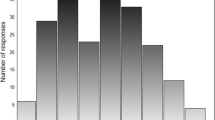Abstract
The aim of this study was to examine whether esophageal dysphagia can be described as a handicap and to grade the severity of handicap as the discrepancy between the subject's own eating goals and his or her eating disability. The severity of the disability-goal-handicap (DGH) regarding dysphagia was expressed on a scale ranging from 0 to 48 points. Nineteen patients with dysphagia of differing causes were selected from a patient register at a laboratory for diagnostic procedures of the esophagus. The severity of handicap for the 19 patients was, on average, 33 points (range, 20–44). The DGH score correlated significantly with the patients' own evaluation of the severity of their dysphagia (p=0.008). The DGH scores did not differ markedly based on patient's sex, age, or cause of dysphagia. Patients who were operated upon because of dysphagia had significantly more points on the DGH scale prior to operation than patients who were not (p=0.001). Denial of dysphagia (N=18), concealment of dysphagia (N=18), and lack of confirmation by the patient's physician (N=15) were common but did not influence the severity of handicap as assessed by the DGH scale. It was shown that dysphagia affects all aspects of life as expressed by reduction in self-esteem (N=13), security (N=16), work capacity (N=8), exercise (N=7), and leisure time (N=6). Esophageal dysphagia may therefore be regarded as a handicap when assessed using the DGH code described in this study.
Similar content being viewed by others

References
Moore HB: The meaning of food.Ann J Clin Nutr 5:77–82, 1957
Menzies IEP: Psychosocial aspects of eating.J Psychosom Res 14:223–227, 1970
Murcott A: The cultural significance of food and eating.Proc Nutr Soc 41:203–210, 1982
Chappelle ML: The language of food.Am J Nursing 72:1294–1295, 1972
Norberg A, Athlin E, Winblad B: A model for the assessment of eating problems in patients with Parkinson's disease.J Adv Nursing 12:473–481, 1987
Tibbling L, Gustafsson B: Dysphagia and its consequences in the elderly.Dysphagia 6:200–202, 1991
Kjellén G, Tibbling L: Manometric oesophageal function, acid perfusion test and symptomatology in a 55-year old general population.Clin Physiol 1:405–415, 1981
Pörn I: An equilibrium model of health. In Nordenfeldt L, Lindahl B (eds):Health, Disease, and Causal Explanations in Medicine. Dordrecht: D Reidel, 1984, pp 3–9
Nordenfelt L: Towards a holistic theory of health. In Nordenfelt L (ed):On the Nature of Health, an Action-Theoretic Approach. Dordrecht: D Reidel, 1987, pp 34–35
Whitbeck C: A theory of health. In Caplan AL, Engelhardt HT Jr, McCartney IJ (eds):Concepts of Health and Disease; Interdisciplinary Perspectives. Reading, MA: Addison-Wesley, 1981, pp 611–626
Pörn I: Vård med helhetssyn,Finska läkarsällskapets handlingar 148:137–140, 1988
World Health Organization:International Classification of Impairments, Disabilities, and Handicaps. Geneva: WHO, 1980, pp 184–207
Nordenfelt L: On disabilities and their classification. InStudies on Health and Society. Linköping, Sweden: University of Linköping, 1983
Söder M: The concept of handicap—a comparison between ICIDH definition and a Swedish definition. In Söder M (ed):Impairment, Disability and Handicap. Stockholm, Sweden: Swedish Council for Planning and Coordination of Research, 1988,1:27–33
Badley EM: The ICIDH: format, application in different settings, and distinction between disability and handicap.Int Disabil Stud 9:122–125, 1987
Minaire P, Florens JL, Cherpin J, Weber D: The functional aptitude of natural sample of population, a new approach to handicap.Int Disabil Stud 9:65–68, 1987
Noble WG, Athevly GRC: The hearing measurement scale: a questionnaire for the assessment of auditory disability.J Aud Res 10:229–250, 1970
Hambraeus GM, Fletcher R, Heden G, Wareborn A: Dysphagia—social implications and indications for surgery. In Hambraeus GM (ed):The Surgical Treatment of Oesphageal Cancer. Medical dissertation, University of Lund, Lund, Sweden, 1986, pp 96–103
Johansson KE, Ask P, Boeryd B, Fransson S-G, Tibbling L: Oesophagitis, signs of reflux, and gastric acid secretion in patients with symptoms of gastrooesophageal reflux disease.Scand J Gastroenterol 21:837–847, 1986
Lindgren S: The prevalence of swallowing complaints among 50–79 year-old men and women in an urban population. In Lindgren S (ed):Swallowing Complaints. Prevalence. Evaluation of Cervical Dysphagia. Medical dissertation, University of Lund, 1989, pp 51–58
Edwards DAW: The problem of dysphagia.Practitioner 216: 631–636, 1976
Nathanson M, Bergman PS, Gordon GG: Denial of illness.Arch Neurol Psychiatry 68:380–387, 1952
Kassebaum GG, Baumann BO: Dimensions of the sick role in chronic illness.J Health Hum Behav 1:16–27, 1965
Bygren LO: Met and unmet needs for medical and social services.Sand J Soc Med Suppl 8, 1974
Novell KT: Remembrance of labor pain: how valid are retrospective pain measurement?Pain 32:77–78, 1987
Tibbling L, Stenkvist M: Foreign bodies in the esophagus. A study on possible causative factors.Dysphagia 6:224–227, 1991
Author information
Authors and Affiliations
Rights and permissions
About this article
Cite this article
Gustafsson, B., Tibbling, L. Dysphagia, an unrecognized handicap. Dysphagia 6, 193–199 (1991). https://doi.org/10.1007/BF02493525
Issue Date:
DOI: https://doi.org/10.1007/BF02493525



